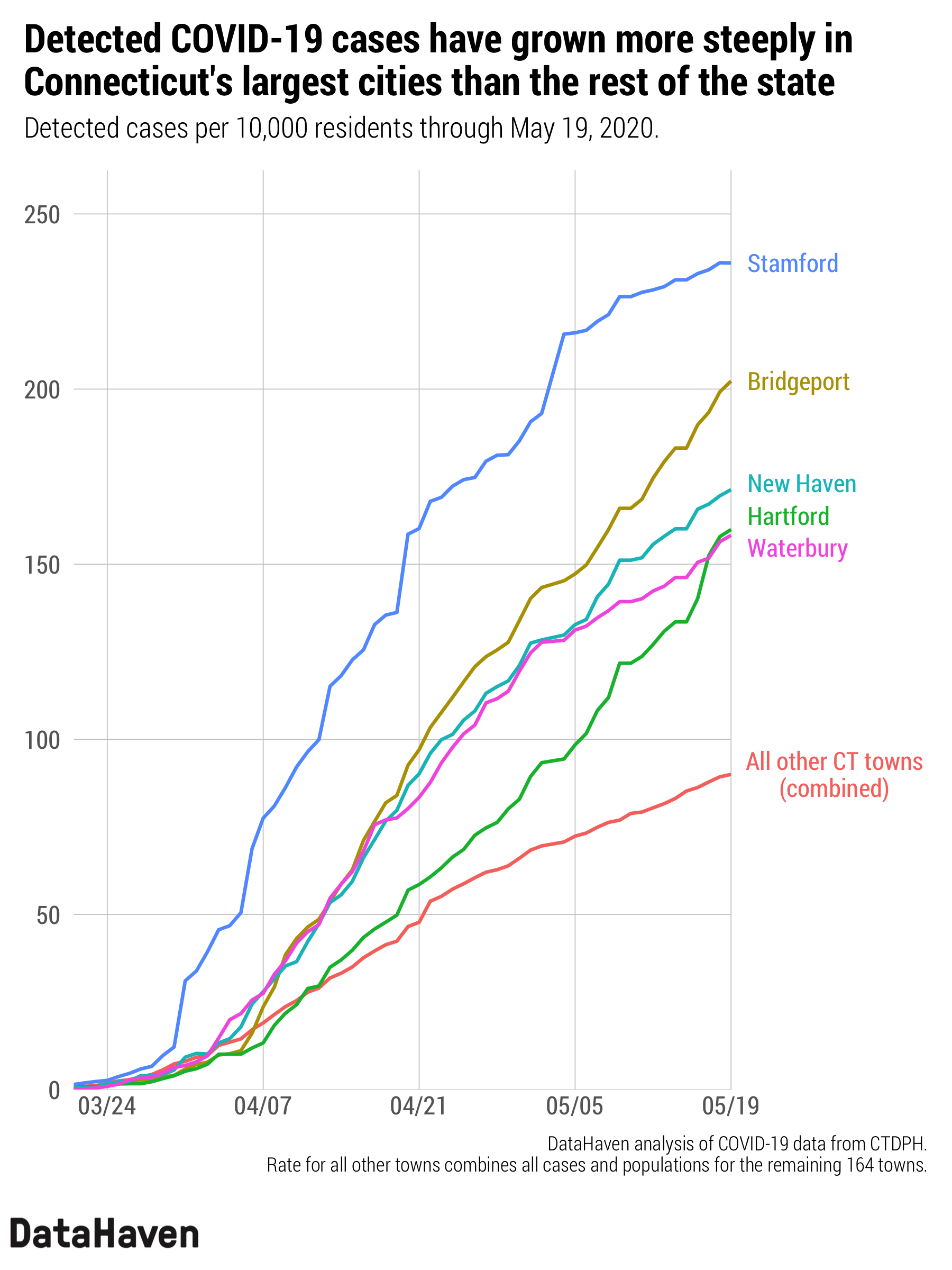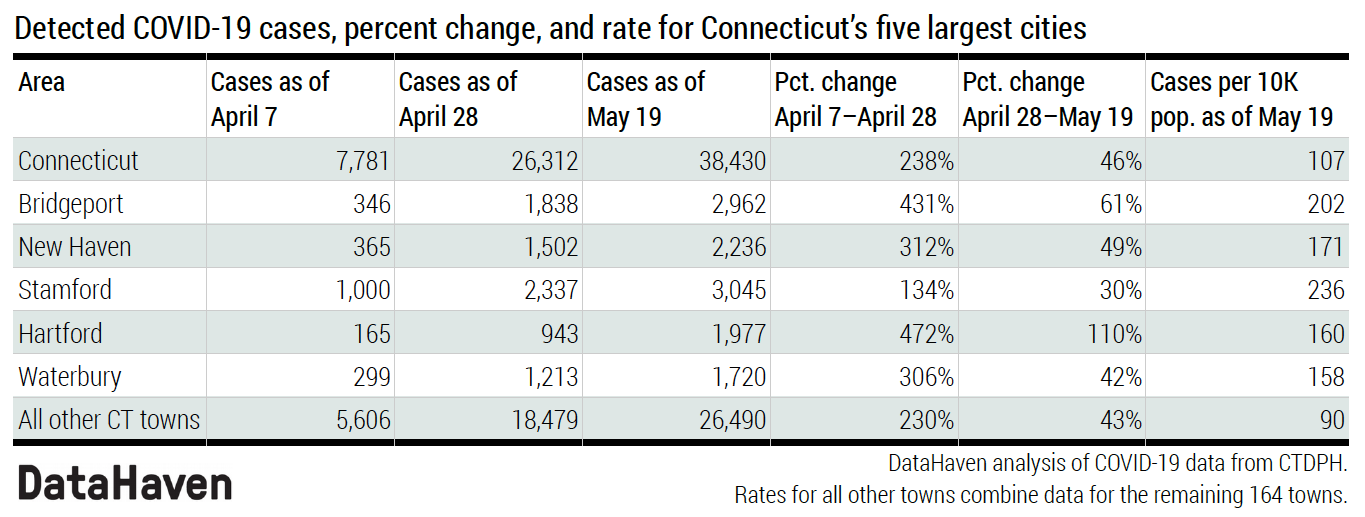All DataHaven Programs, Health
DataHaven Analysis: Despite statewide improvements, COVID-19 cases remain high in the five largest cities
Cities also reporting a greater share of deaths outside of nursing homes
FOR IMMEDIATE RELEASE – May 20, 2020
A new analysis by DataHaven suggests that COVID-19 continues to affect the state in disproportionate ways.
Growth in new cases has slowed statewide, but the change of pace has been uneven from town to town.
From April 28 to May 19, detected COVID-19 cases have grown from 26,312 to 38,430 statewide—an increase of 46 percent. This is down from 238 percent growth in reported cases from April 7 to April 28. However, in the five largest cities, collectively, detected cases have grown by 52 percent in the past three weeks (rising from 7,833 to 11,940), after rising by 260 percent in the previous three weeks (from 2,175 cases on April 7 to 7,833 cases on April 28).
Controlling for population, the rate of detected cases is more than twice as high in the largest cities compared to the rest of the state. About 185 per 10,000 residents of the five largest cities have tested positive, compared to 90 per 10,000 residents in the rest of the state.
“As the state moves to lift restrictions on activities and institute policies that will improve health and well-being over the long term, it will be critical to use local data to monitor how COVID-19 is impacting communities in different ways. This is especially true considering that improvements to the health or economy of the state as a whole can easily mask worsening conditions in certain neighborhoods and communities,” said Mark Abraham, Executive Director of DataHaven.
Detected cases could be growing more quickly in cities because of increased testing, but there are also more essential workers living in cities, more overcrowded households, and higher rates of poverty and other economic conditions that underlie poor health and facilitate the transmission of the virus. These are documented in a forthcoming publication by DataHaven, Towards Health Equity in Connecticut: The Role of Social Inequality and the Impact of COVID-19.
Data from Connecticut and elsewhere nationally have documented large disparities in cases by race and ethnicity, which are the outcomes of longstanding patterns of discrimination and other economic and social inequities facing those populations. According to DataHaven’s COVID-19 analysis, the rate of detected cases stood at 136, 119, 50, and 36 per 10,000 Black, Latino, White, and Asian residents, respectively, for the roughly two-thirds of cases for which race/ethnicity was reported in Connecticut on May 19.
Information is also emerging on disparities in COVID-19-related deaths in Connecticut’s five largest cities, but limitations to the data underscore the need to better understand differences within the state.
COVID-19-related deaths among nursing home residents are rising quickly, but unevenly across the state. As of May 16, nursing home deaths accounted for 1,927 of the 3,339 COVID-19 deaths in Connecticut—nearly 60 percent of the statewide total. However, deaths that have occurred outside of nursing homes comprise the majority of COVID-19 deaths in the five largest cities. Preliminary analysis by DataHaven shows that deaths in nursing homes account for 23 percent of the 134 COVID-19 deaths in Bridgeport, and between 36 and 53 percent of deaths in the state’s four other large cities (see graphic). In the remainder of the state’s towns and cities, deaths among nursing home residents account for 61 percent of COVID-19 deaths.
Although data on COVID-19 deaths are unevenly reported and difficult to align, DataHaven analysis of CTDPH data suggests that deaths among nursing home residents have increased by 151 percent in the past four weeks. During the same period, deaths outside of nursing homes have increased by 36 percent. Yet deaths outside of nursing homes have increased by 81 percent in the past four weeks in Bridgeport, according to preliminary analysis.
Connecticut has made progress addressing the COVID-19 pandemic. Residents and frontline workers following social distancing guidelines have saved about 14,000 lives between mid-March and mid-May, a previous DataHaven report estimated. However, concerns remain.
One bright spot is that the number of patients in hospitals for COVID-19-related symptoms has declined for 26 of the past 30 days. For the first time since early April, fewer than a thousand patients are currently hospitalized. More granular data on hospitalization trends are not yet publicly available, although maps released by the New Haven Health Department suggest that hospitalized patients are far more likely to live in low-income neighborhoods.
Additionally, more residents are able to access tests as the capacity of testing facilities increases. This has brought down the share of people testing positive among all people tested in Connecticut since early March from a peak of 32 percent on April 23 to 21 percent as of May 19.
Although testing has increased, experts from the World Health Organization and elsewhere believe the positive rate should be 10 percent or less in order for testing to be considered adequate, because higher rates suggest that there are many cases in the community which have not been detected, including cases among people who have no symptoms.
Access to testing continues to be a concern of public health leaders throughout Connecticut’s cities and rural areas, and may influence where and among whom new cases are detected.
“As the pandemic continues, understanding how communities are affected and addressing the emerging differences in access to health-related services and other resources within neighborhoods and communities will become an increasingly important strategy to protect everyone’s health and improve the social and economic well-being of the state as a whole,” noted Abraham.
DataHaven is a New Haven-based non-profit organization with a 25-year history of public service to Connecticut communities. Its mission is to empower people to create thriving communities by collecting and ensuring access to data on well-being, equity, and quality of life.



